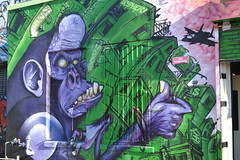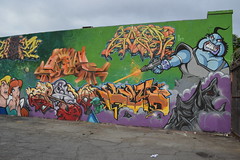Rick Helderman
Though McLogan's may cater to a mostly industrial or hobbyist crowd for screen printing and sign printing materials, its manager sees the store stocking more artist supplies in the future. Helderman supports the ambitions of artists in whatever they are pursuing by giving them technical advice on how to accomplish their vision. He believes in the power of art to lift one's spirits and this area out of its run-down conditions.
Fewer fences are going up. Fewer cameras are being installed. And forget window guards. That’s bad news for Jeffrey Marks and a nearly 45-year-old family-owned business. HIMCO Security Products has been forced to downsize during the recession and lease a majority of its huge facility to companies in the reborn sewing industry.
For over 20 years Los Amigos Shopping Mall has embraced cultural and ethnic diversity. The outdoor mall is home to over 100 shops and restaurants catering to the South Los Angeles community. The shops range from a tattoo parlor, to religious gift shops selling framed light-up Last Supper paintings. The mall has been able to endure tough economic times due to the variety of shops and services it provides.
La Dona Mariscos is a “hole in the wall” Mexican restaurant located in Los Angeles that has been run by mother-daughter team Josephine Lugo and Grace Cervantez for the past 23 years. The restaurant business has proved both rewarding and troubling for the hardworking ladies, but ultimately has shaped their restaurant into what locals call a “neighborhood gem.”
The Papillion Institute of Art Connects Communities
Michelle Joan Papillion, founder of the Papillion Institute of Art, located South Main St. off of West Washington Blvd., wanted to make a new kind of approachable art space for artists and locals to gather. Since opening last spring, the Institute has been able to host many exhibitions, provide an artist in residence workspace, offer education about the arts, and work to bring fine arts into a comfortable setting.
After moving to Los Angeles three years ago, Papillion realized that the city was missing a place that people from different communities could come together to view and create art.
“I decided I wanted to open an art space because there was a disconnect between the art community in Los Angeles. Everything was very compartmentalized within the arts in the city. You had painters who only hung out with painters, photographers who only hung out with photographers. Everyone was in these sections…In New York it didn’t matter what you did, everyone communed together,” Papillion said.
The Institute was her answer to the need she saw around her in her new city. She opened the doors of her 1200-square-foot gallery on April 15, 2010 with the first group exhibition, “The Hello Show,” to rave reviews and a warm reception from the community.
“From the beginning, we have always shown international artists. We work with local artists, but we work with artists from all over the country and literally all over the world,” Papillion said.
The space functions as an ever-changing chameleon that can host a film screening one night, a music performance the next, and a mixed-media art show the next week. Papillion welcomes any art form, whether it is photography, painting, illustration, digital arts, performance work, or something she has never experienced before.
While the people who fill the space’s walls might be from all over, the artist in residence program allows for a local artist to have materials and workspace to create new artwork that will later be shown in the gallery. This commitment to supporting artists in their craft as well as arts education has been one of Papillion and her small staff’s goals from the start.
Monitored by a team of interns, the Institute focuses on its online presence through Facebook, Twitter, their own website, and multiple blog accounts. These allow for online discussion about art and a place to stream its art openings and artist talks live in a place that is open to everyone.
This might seem like a lot of different projects going on simultaneously in just over a year, but Papillion feels this is just part of the experience. “We’re very ambitious. We have a lot of plans for the space. We waste no time in trying to get things done around here,” she said.
As proof of this sort of work ethic, the Institute is readying another new show just a few weeks after the close of its last show. This month, the “Now” exhibition showcasing what artists have just made this year will open and will stay open until after Christmas.
“[There is] mixed media, some painting, some photography. It’s just individual artists that we have worked with before and other artists that we were interested in working with but we hadn’t had a chance to before,” Papillion said.
The ever-multi-tasking Papillion has a lot of upcoming projects for the new year she is excited about finishing. In addition to finally launching PIA TV, which is “carefully curated content about art and the culture that thrives around it,” as she puts it, in January, the Institute will roll out a whole new website to host all of their different ventures in one platform.
“We are all about meeting people where they’re at and those people are watching things on their computers anyway. We are all about the digital world. We have been working on PIA TV for a whole year,” Papillion said.
This neighborhood has never seen anything like this before, but Papillion firmly believes that this is a step in the right direction for the community, a step that could one day make them into their very own art district.
---------------------------------------------------------------
St. Francis Center's Mural Program: A Conversation With Guy Ellis
The St. Francis Center, mainly known for its work with the homeless and with feeding impoverished families, has expanded to provide art programs for youth and teens that include drawing, painting, photography, and mural classes taught by the artist Guy Ellis who painted the murals that coat the center’s walls. Their newest programs start up again in January.
“We wanted to steer away from tagging and more towards mural compositions, with an artist leading the workshop. Guy Ellis, the artist who did the murals on the sides of our building, worked with us before and now he’s coming back,” said Jose Ramirez, the Chief Operating Officer of the Center.
The Center had lots of free wall space and after Ellis and his collaborators finished their work, the neighbors wanted their own murals. Ramirez counts the brightening effect the murals have on otherwise drab walls and a general appreciation for the art as bonuses for the area. “It still hasn’t been defaced,” Ramirez added.
Their combined youth programs, including arts and sports camps, serviced over 300 children this past summer. Most children who attend come from the families who frequent the Center each week for groceries and live within walking distance. In January, the classes for drawing, painting, photography, and mural painting will start small, but the Center hopes to surpass its previous numbers.
I spoke to Ellis, who has been teaching graffiti and mural art forms for the last seven years, about the role of art in the Central community, how he got started, and what street art has to offer the youth in Los Angeles.
What role does art play in this community around the Center?
I feel the murals bring a revitalizing energy to the area that has been otherwise dismissed from having any cultural influences. It draws in people that otherwise would have no drive to visit this desolate area. The center's goal of providing food for the homeless and low- income community in the area is amazing and helping to revitalize the front of the building and create a new and exciting visual premise to the site that otherwise had a depressing quality to it was an honor!
What does art mean to you? Why is it important to make these art programs available to kids in this area?
Art to me is everything; it is my life source. Without it I would have no reason to live apart from my friends and family of course. I feel it has eminence, the power of persuasion and is a necessity for people to express themselves in the visual realm of the city that is otherwise riddled with advertising that has no real cultural qualities and expresses consumer culture at its worst! Art is uplifting and can change people’s lives who otherwise thought they had no real reason to live, especially teenagers who have a hard time being listened to or even noticed by their friends and families and communities. I feel if I can introduce them to becoming creative, their quality of life will take a giant leap forward!
How did you get involved with art? With muralism?
I have been drawing since I could pick up a pencil/crayon and knew that I wanted to become an artist from a very young age. In my teenage years, my father bought me a book from a garage sale called “Subway Art” which was a product of two photographers documenting graffiti history on subway trains in the late 1970s through the early 1980s.This book really captured my attention and I proceeded to re-create and develop my own illegal and legal graffiti art for my entire teenage life and to this day.
Why do you think a lot of kids are interested in street art and murals?
Graffiti art is the largest art movement in world history and the only art movement created by youth. It’s exciting and has a rebel aspect that most teenagers can and feel they should identify with to make changes in this world. It’s unadulterated, easily achieved, extremely fun and gives them a sense of well-being through positive affirmation from their peers and community alike.







